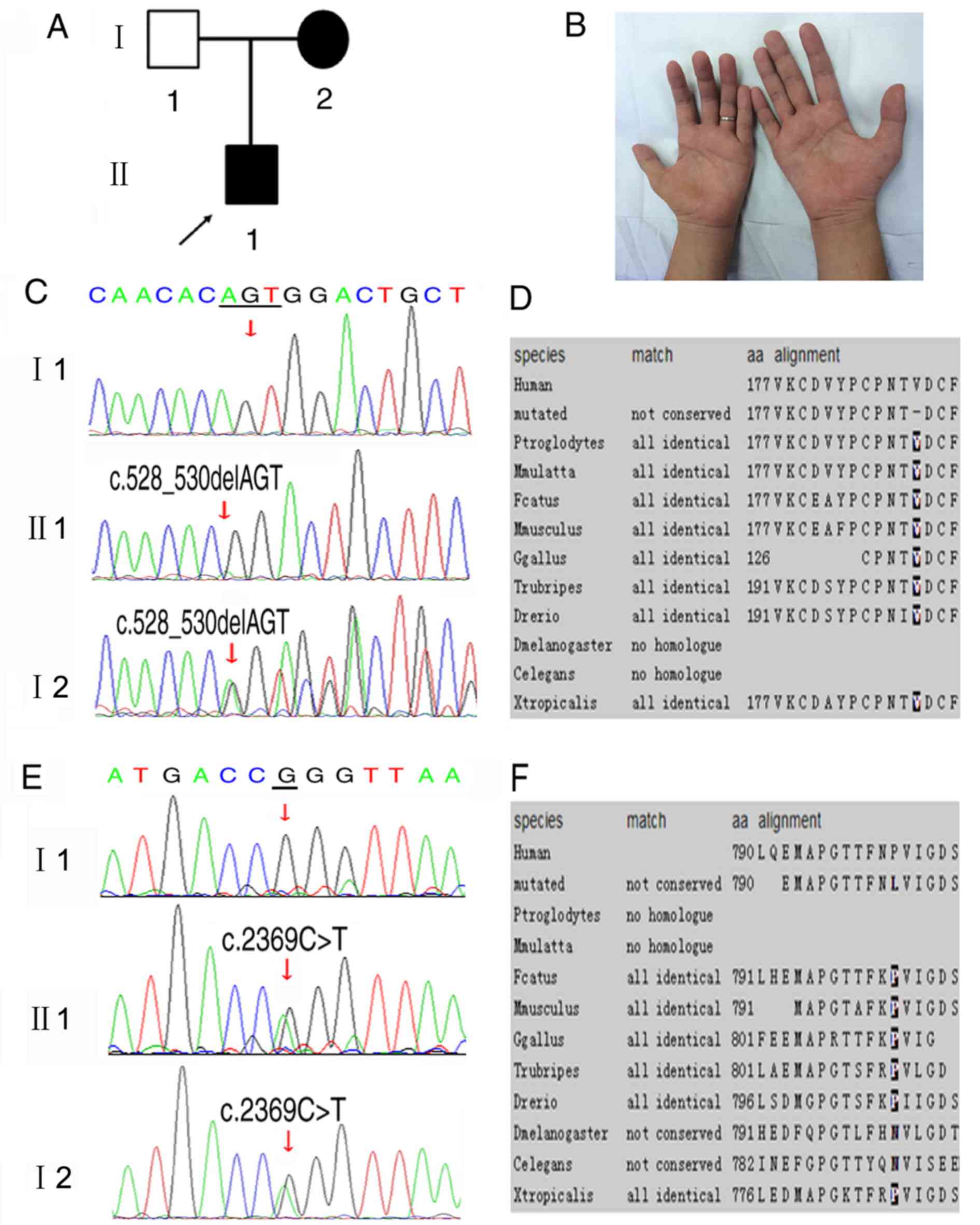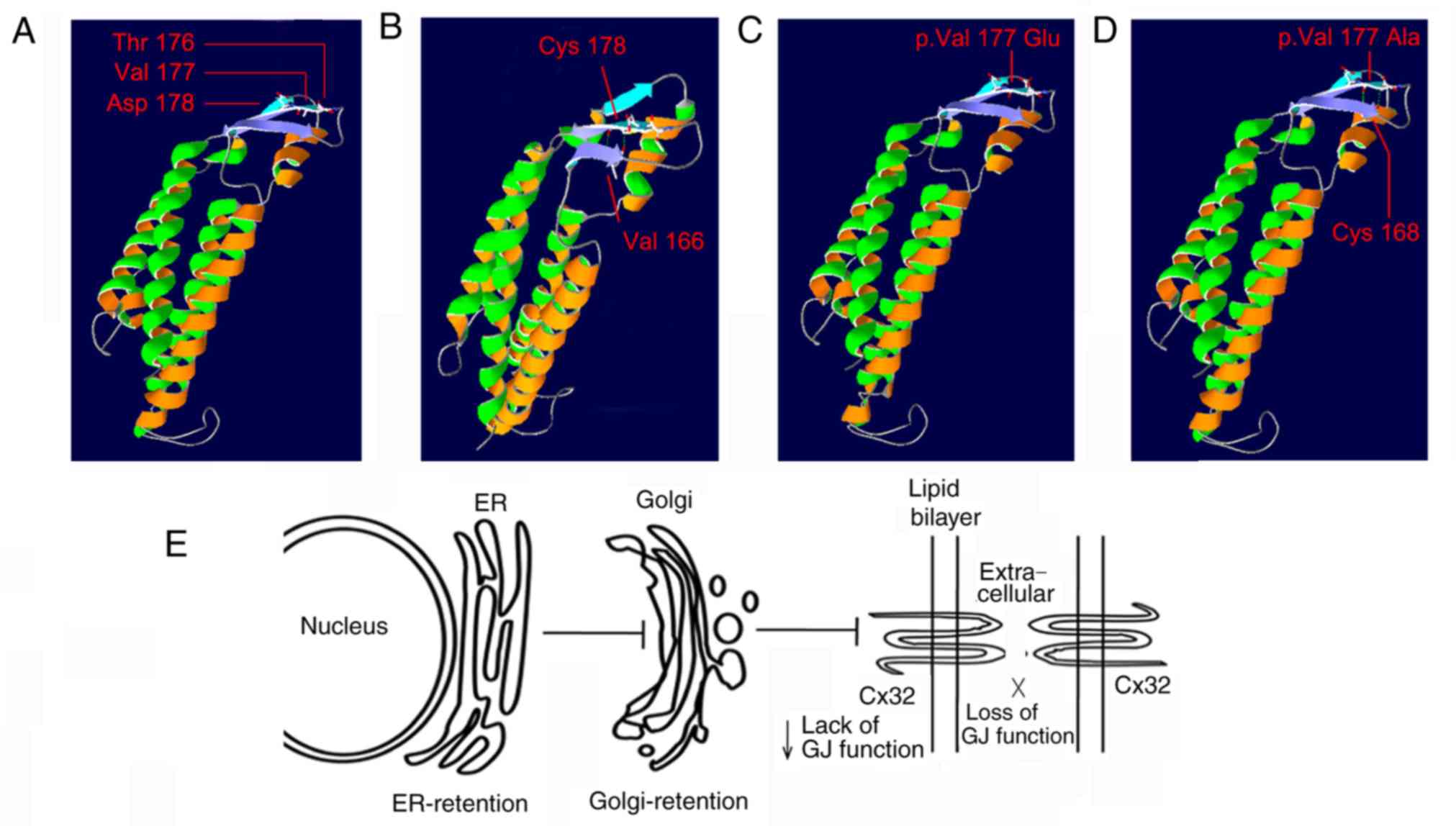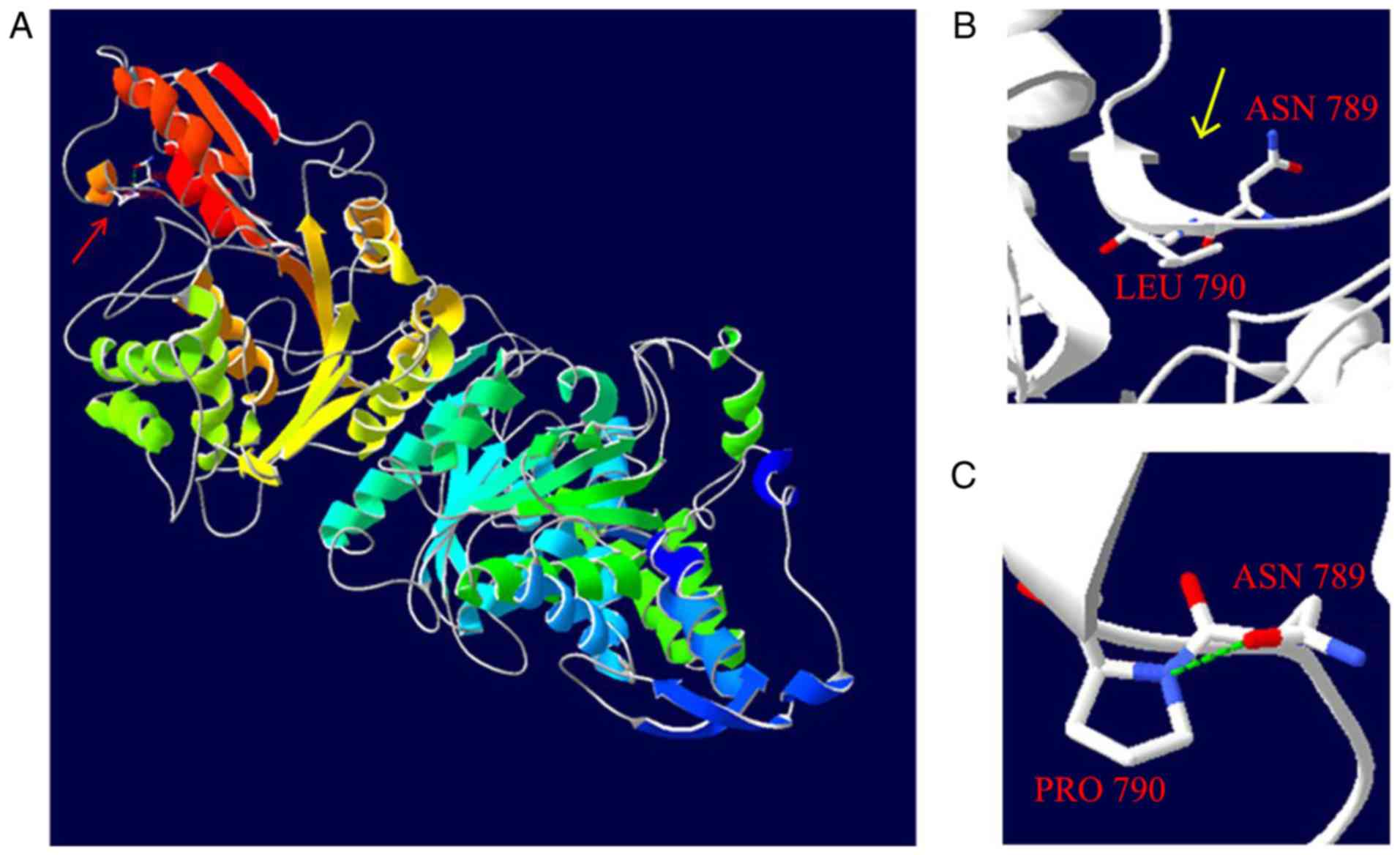|
1
|
Kazamel M and Boes CJ: Charcot marie tooth
disease (CMT): Historical perspectives and evolution. J Neurol.
262:801–805. 2015. View Article : Google Scholar : PubMed/NCBI
|
|
2
|
Timmerman V, Strickland AV and Zuchner S:
Genetics of Charcot-Marie-Tooth (CMT) disease within the frame of
the human genome project success. Genes (Basel). 5:13–32. 2014.
View Article : Google Scholar : PubMed/NCBI
|
|
3
|
Ionasescu VV, Ionasescu R and Searby C:
Screening of dominantly inherited Charcot-Marie-Tooth neuropathies.
Muscle Nerve. 16:1232–1238. 1993. View Article : Google Scholar : PubMed/NCBI
|
|
4
|
Bennett MV, Barrio LC, Bargiello TA, Spray
DC, Hertzberg E and Sáez JC: Gap junctions: New tools, new answers,
new questions. Neuron. 6:305–320. 1991. View Article : Google Scholar : PubMed/NCBI
|
|
5
|
Li H and Durbin R: Fast and accurate short
read alignment with burrows-wheeler transform. Bioinformatics.
25:1754–1760. 2009. View Article : Google Scholar : PubMed/NCBI
|
|
6
|
Li R, Li Y, Fang X, Yang H and Wang J,
Kristiansen K and Wang J: SNP detection for massively parallel
whole-genome resequencing. Genome Res. 19:1124–1132. 2009.
View Article : Google Scholar : PubMed/NCBI
|
|
7
|
McKenna A, Hanna M, Banks E, Sivachenko A,
Cibulskis K, Kernytsky A, Garimella K, Altshuler D, Gabriel S, Daly
M and DePristo MA: The genome analysis toolkit: A MapReduce
framework for analyzing next-generation DNA sequencing data. Genome
Res. 20:1297–1303. 2010. View Article : Google Scholar : PubMed/NCBI
|
|
8
|
Schwarz JM, Cooper DN, Schuelke M and
Seelow D: MutationTaster2: Mutation prediction for the
deep-sequencing age. Nat Methods. 11:361–362. 2014. View Article : Google Scholar : PubMed/NCBI
|
|
9
|
Waterhouse A, Bertoni M, Bienert S, Studer
G, Tauriello G, Gumienny R, Heer FT, de Beer TAP, Rempfer C,
Bordoli L, et al: SWISS-MODEL: Homology modelling of protein
structures and complexes. Nucleic Acids Res. 46:W1. W296–W303.
2018. View Article : Google Scholar : PubMed/NCBI
|
|
10
|
Bienert S, Waterhouse A, de Beer TA,
Tauriello G, Studer G, Bordoli L and Schwede T: The SWISS-MODEL
Repository-new features and functionality. Nucleic Acids Res.
45(D1): D313–D319. 2017. View Article : Google Scholar : PubMed/NCBI
|
|
11
|
Guex N, Peitsch MC and Schwede T:
Automated comparative protein structure modeling with SWISS-MODEL
and Swiss-PdbViewer: A historical perspective. Electrophoresis. 30
(Suppl 1):S162–S173. 2009. View Article : Google Scholar : PubMed/NCBI
|
|
12
|
Benkert P, Biasini M and Schwede T: Toward
the estimation of the absolute quality of individual protein
structure models. Bioinformatics. 27:343–350. 2011. View Article : Google Scholar : PubMed/NCBI
|
|
13
|
Bertoni M, Kiefer F, Biasini M, Bordoli L
and Schwede T: Modeling protein quaternary structure of homo- and
hetero-oligomers beyond binary interactions by homology. Sci Rep.
7:104802017. View Article : Google Scholar : PubMed/NCBI
|
|
14
|
Shy ME, Blake J, Krajewski K, Fuerst DR,
Laura M, Hahn AF, Li J, Lewis RA and Reilly M: Reliability and
validity of the CMT neuropathy score as a measure of disability.
Neurology. 64:1209–1214. 2005. View Article : Google Scholar : PubMed/NCBI
|
|
15
|
Richards S, Aziz N, Bale S, Bick D, Das S,
Gastier-Foster J, Grody WW, Hegde M, Lyon E, Spector E, et al:
Standards and guidelines for the interpretation of sequence
variants: A joint consensus recommendation of the American college
of medical genetics and genomics and the association for molecular
pathology. Genet Med. 17:405–424. 2015. View Article : Google Scholar : PubMed/NCBI
|
|
16
|
Yuan JH, Sakiyama Y, Hashiguchi A, Ando M,
Okamoto Y, Yoshimura A, Higuchi Y and Takashima H: Genetic and
phenotypic profile of 112 patients with X-linked
Charcot-Marie-Tooth disease type 1. Eur J Neurol. 25:1454–1461.
2018. View Article : Google Scholar : PubMed/NCBI
|
|
17
|
Wang Y and Yin F: A review of X-linked
Charcot-Marie-Tooth disease. J Child Neurol. 31:761–772. 2016.
View Article : Google Scholar : PubMed/NCBI
|
|
18
|
Scherer SS, Xu YT, Nelles E, Fischbeck K,
Willecke K and Bone LJ: Connexin32-null mice develop demyelinating
peripheral neuropathy. Glia. 24:8–20. 1998. View Article : Google Scholar : PubMed/NCBI
|
|
19
|
Hahn AF, Brown WF, Koopman WJ and Feasby
TE: X-linked dominant hereditary motor and sensory neuropathy.
Brain. 113:1511–1525. 1990. View Article : Google Scholar : PubMed/NCBI
|
|
20
|
Williams MM, Tyfield LA, Jardine P, Lunt
PW, Stevens DL and Turnpenny PD: HMSN and HNPP. Laboratory service
provision in the south west of England-two years' experience. Ann N
Y Acad Sci. 883:500–503. 1999. View Article : Google Scholar
|
|
21
|
Ikegami T, Lin C, Kato M, Itoh A, Nonaka
I, Kurimura M, Hirayabashi H, Shinohara Y, Mochizuki A and Hayasaka
K: Four novel mutations of the connexin 32 gene in four Japanese
families with Charcot-Marie-Tooth disease type 1. Am J Med Genet.
80:352–355. 1998. View Article : Google Scholar : PubMed/NCBI
|
|
22
|
Deschênes SM, Walcott JL, Wexler TL,
Scherer SS and Fischbeck KH: Altered trafficking of mutant
connexin32. J Neurosci. 17:9077–9084. 1997. View Article : Google Scholar : PubMed/NCBI
|
|
23
|
Kleopa KA, Yum SW and Scherer SS: Cellular
mechanisms of connexin32 mutations associated with CNS
manifestations. J Neurosci Res. 68:522–534. 2002. View Article : Google Scholar : PubMed/NCBI
|
|
24
|
Yum SW, Kleopa KA, Shumas S and Scherer
SS: Diverse trafficking abnormalities of connexin32 mutants causing
CMTX. Neurobiol Dis. 11:43–52. 2002. View Article : Google Scholar : PubMed/NCBI
|
|
25
|
VanSlyke JK, Deschenes SM and Musil LS:
Intracellular transport, assembly, and degradation of wild-type and
disease-linked mutant gap junction proteins. Mol Biol Cell.
11:1933–1946. 2000. View Article : Google Scholar : PubMed/NCBI
|
|
26
|
Oh S, Ri Y, Bennett MV, Trexler EB,
Verselis VK and Bargiello TA: Changes in permeability caused by
connexin 32 mutations underlie X-linked Charcot-Marie-Tooth
disease. Neuron. 19:927–938. 1997. View Article : Google Scholar : PubMed/NCBI
|
|
27
|
Nakagawa S, Maeda S and Tsukihara T:
Structural and functional studies of gap junction channels. Curr
Opin Struct Biol. 20:423–430. 2010. View Article : Google Scholar : PubMed/NCBI
|
|
28
|
Nualart-Marti A, Solsona C and Fields RD:
Gap junction communication in myelinating glia. Biochim Biophys
Acta. 1828:69–78. 2013. View Article : Google Scholar : PubMed/NCBI
|
|
29
|
Bortolozzi M: What's the function of
connexin 32 in the peripheral nervous system? Front Mol Neurosci.
11:2272018. View Article : Google Scholar : PubMed/NCBI
|
|
30
|
Wang HL, Chang WT, Yeh TH, Wu T, Chen MS
and Wu CY: Functional analysis of connexin-32 mutants associated
with X-linked dominant Charcot-Marie-Tooth disease. Neurobiol Dis.
15:361–370. 2004. View Article : Google Scholar : PubMed/NCBI
|
|
31
|
Castro C, Gómez-Hernandez JM, Silander K
and Barrio LC: Altered formation of hemichannels and gap junction
channels caused by C-terminal connexin-32 mutations. J Neurosci.
19:3752–3760. 1999. View Article : Google Scholar : PubMed/NCBI
|
|
32
|
Abrams CK, Islam M, Mahmoud R, Kwon T,
Bargiello TA and Freidin MM: Functional requirement for a highly
conserved charged residue at position 75 in the gap junction
protein connexin 32. J Biol Chem. 288:3609–3619. 2013. View Article : Google Scholar : PubMed/NCBI
|
|
33
|
Shy ME, Siskind C, Swan ER, Krajewski KM,
Doherty T, Fuerst DR, Ainsworth PJ, Lewis RA, Scherer SS and Hahn
AF: CMT1X phenotypes represent loss of GJB1 gene function.
Neurology. 68:849–855. 2007. View Article : Google Scholar : PubMed/NCBI
|
|
34
|
Panosyan FB, Laura M, Rossor AM, Pisciotta
C, Piscosquito G, Burns J, Li J, Yum SW, Lewis RA, Day J, et al:
Cross-sectional analysis of a large cohort with X-linked
Charcot-Marie-Tooth disease (CMTX1). Neurology. 89:927–935. 2017.
View Article : Google Scholar : PubMed/NCBI
|
|
35
|
Xu WY, Gu MM, Sun LH, Guo WT, Zhu HB, Ma
JF, Yuan WT, Kuang Y, Ji BJ, Wu XL, et al: A nonsense mutation in
DHTKD1 causes Charcot-Marie-Tooth disease type 2 in a large Chinese
pedigree. Am J Hum Genet. 91:1088–1094. 2012. View Article : Google Scholar : PubMed/NCBI
|
|
36
|
Hagen J, te Brinke H, Wanders RJ, Knegt
AC, Oussoren E, Hoogeboom AJ, Ruijter GJ, Becker D, Schwab KO,
Franke I, et al: Genetic basis of alpha-aminoadipic and
alpha-ketoadipic aciduria. J Inherit Metab Dis. 38:873–879. 2015.
View Article : Google Scholar : PubMed/NCBI
|












